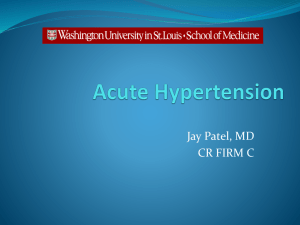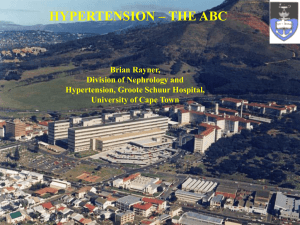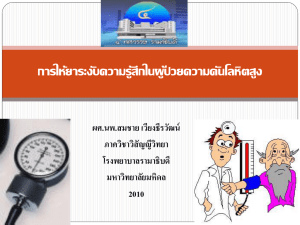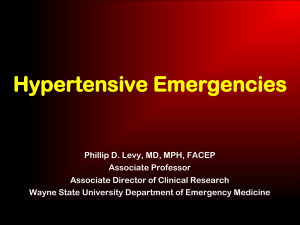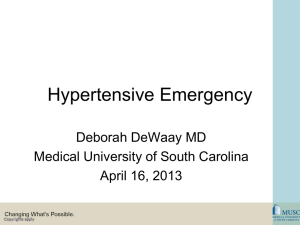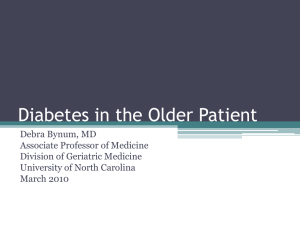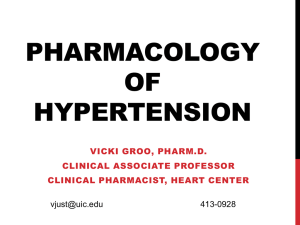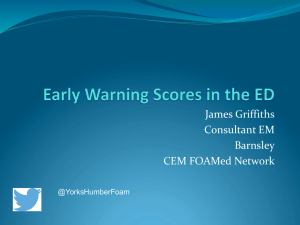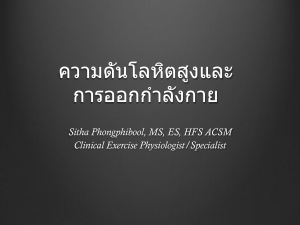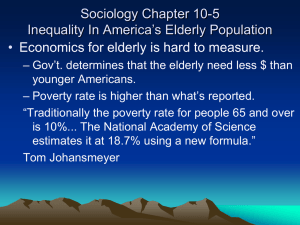mm Hg - Lafmeded.org
advertisement
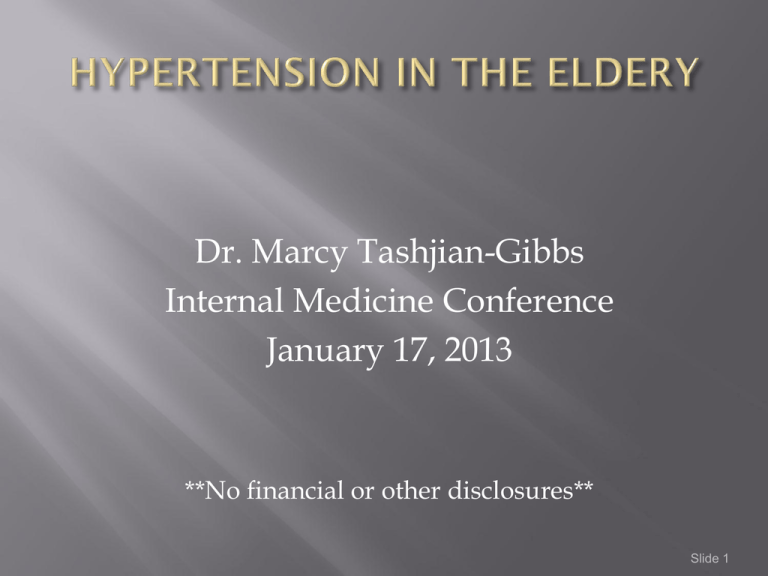
Dr. Marcy Tashjian-Gibbs Internal Medicine Conference January 17, 2013 **No financial or other disclosures** Slide 1 Know and understand: • How the diagnosis and treatment of hypertension differ in older adults • When to recommend lifestyle modification • How to choose among the various classes of antihypertensive agents • The principles of adjusting therapy • Most recent literature Slide 2 • Epidemiology And Physiology • Clinical Evaluation • Treatment Lifestyle modification Pharmacologic treatment Follow-up visits • Special Considerations Hypertensive emergencies and urgencies Hypertension in the long-term care setting • RECENT LITERATURE -> changes in management Slide 3 BP increases with age, especially SBP and pulse pressure (difference between SBP and DBP) In Americans ≥65 years, the prevalence of hypertension (HTN) is: • 50% to 70% • Highest among blacks • Higher in women than men The proportion of older patients with HTN whose BP is controlled is low. Slide 4 Category Normal Systolic (mm Hg) Diastolic (mm Hg) <120 and <80 Prehypertension 120–39 or 80–89 Hypertension Stage 1 Stage 2 140–159 >160 or 90–99 >100 Slide 5 • Increased arterial stiffness • Decline in baroreflex sensitivity • Increase in sympathetic nervous system activity • Heightened vasoconstriction • Alterations in renal function and neurohumoral systems involved in sodium balance sodiumsensitive HTN Slide 6 Use the average of several readings taken at each of 3 visits Consider ambulatory BP monitoring for patients with extreme BP variability or possible “white coat” HTN Determine SBP by palpation to avoid auscultatory gap Slide 7 Exclude secondary forms of HTN Identify target organ damage Determine CVD risk factors and identify comorbidities Inquire about lifestyle (smoking history, dietary intake of sodium and fat, alcohol intake, physical activity) Slide 8 Treatment reduces overall mortality, CVD events, heart failure, and stroke Treatment effect is greatest in men, patients older than 70 years, and patients with greater pulse pressure Slide 9 Focus on SBP and pulse pressure • In general: –SBP 135 to 140 mm Hg –DBP <90 mm Hg • Type 2 diabetes: SBP <130 mm Hg If SBP is very high, an intermediate target (eg, 160 mm Hg) may be a better initial goal in the absence of target-organ damage Slide 10 6-month trial for nondiabetics with stage 1 HTN Adjunct to drug therapy for all hypertensive patients Components: • • • • • • Weight reduction Aerobic exercise and strength training Smoking cessation Moderation of alcohol intake Decreased sodium, saturated fat, cholesterol Maintain adequate intake of potassium, magnesium and calcium Slide 11 Start with a low-dose thiazide-type diuretic If BP is >20 mm Hg above target, start with diuretic plus ACE inhibitor Initiate therapy at half the usual dose; increase dose slowly Slide 12 Avoid excessively low DBP (<70 mm Hg) Do not use aggressive therapy if adverse effects (eg, postural hypotension) cannot be avoided Avoid centrally acting agents and those likely to produce postural hypotension Continue nonpharmacologic therapies Slide 13 Preferred for initial therapy because of: • Relative safety • Once-daily dosing • Low cost • Significant benefits in mortality, stroke and coronary events Better than other agents at reducing SBP Potassium replacement is important to prevent arrhythmias, minimize glucose intolerance Slide 14 Can be used as initial monotherapy for simple HTN in older patients, especially men Generally well tolerated (except for cough) No adverse CNS or metabolic effects Well suited to patients with diabetes and those with LV systolic dysfunction Slide 15 Not well studied in older hypertensive patients Not an appropriate initial monotherapy An option for patients with diabetes, heart failure, or chronic kidney disease, especially those unable to tolerate ACE inhibitors Slide 16 Reduce peripheral vascular resistance No adverse CNS or metabolic effects An option for second-line therapy, generally with a thiazide-type diuretic Use at low doses (pharmacokinetics change with advancing age) Do not use short-acting CCAs to treat HTN Slide 17 Not recommended for first-line monotherapy Less effective than diuretics in reducing BP and preventing CVD events, stroke, and death Consider for patients with symptomatic CAD, those with a history of MI, and certain patients with heart failure Slide 18 High risk of postural hypotension in older patients When used as monotherapy, associated with a high rate of CVD events (new-onset heart failure) in a large-scale clinical trial May be considered, usually in combination with another drug, for older men with prostatism Slide 19 Assess adherence to therapy Monitor for adverse effects, especially postural hypotension Measure supine and standing BP Adjust dosage cautiously – “start low and go slow” In general, allow 1 to 2 months between visits Except in hypertensive emergencies, rapid reduction of BP is unnecessary and likely deleterious Slide 20 Definition Vascular compromise of vital organs due to extreme BP elevation (eg, hypertensive encephalopathy, pulmonary edema, aortic dissection, unstable angina) Management In hospital with continuous BP monitoring Parenteral administration of antihypertensive Do not initially target a normal BP level Try to achieve 160/100 mm Hg gradually over first 6 hours Slide 21 Defined as cases in which BP should be lowered within 24 hours to prevent target-organ damage Most can be managed with oral antihypertensive medications Slide 22 HTN affects about 33% to 66% of residents of long-term care (LTC) facilities Postprandial hypotension • Affects about 33% of residents • Independent risk factor for falls, syncope, stroke, mortality Slide 23 No well-designed trials have studied antihypertensive treatment in the LTC setting Risk-benefit ratio of treatment is unclear in: • Patients older than 80 years • Patients with multiple comorbidities, taking multiple medications Antihypertensive medications are a risk factor for falls, so assess postural and postprandial BP Slide 24 2 recent studies that have specifically explored hypertension in the elderly JATOS STUDY – 2 subgroup studies Association of Blood Pressure Control and Metabolic Syndrome With Cardiovascular Risk in Elderly Japanese Comparison of Strict and mild blood pressure control in elderly hypertensive patients: a per-protocol analysis of JATOS HYVET STUDY Blood Pressure control in the Hypertension in the Very Elderly Trial Slide 25 Blood Pressure Control in the Hypertension in the Very Elderly Trial Main Objective: To identify any reduction in stroke events, and relate this change and any change in total mortality, cardiac mortality and cardiovascular events to the difference in blood pressure between the groups To look specifically at patients over the age of 80 Slide 26 After giving consent, patients were given a placebo Seen again in 1 and 2 months Sitting blood pressure after 1 and 2 months measured twice after a rest of 5 minutes giving 4 readings of sitting blood pressure Eligible for randomization: Average of systolic readings 160-199 and Average of diastolic readings 90-109 Slide 27 Eventually requirement for both systolic and diastolic were dropped Patients randomized with a diastolic pressure <110 if systolic was 160-199 2 groups (SDH and ISH) Standing systolic pressure measured at 2 months and patients excluded if standing BP <140 due to risk of postural hypotension Participants followed at 3, 6, 9 and 12 months, and 6 months thereafter KEY: BP GOAL 150/80 Slide 28 12% of SDH controlled on placebo at 2 years SDH with active treatment 5.7% controlled on monotherapy 33% controlled after full titration 39% controlled at 2 years, 75% had systolic controlled at 2 years ISH with active treatment Full control achieved in 62% of all ISH patients Systolic control in 73% and diastolic control in 77% Slide 29 Reduction in stroke – 30% Reduction in Total Mortality – 21% Reduction in Heart Failure – 64% REMINDER: Goal BP in study was 150/80 Question becomes should this be the goal BP for treatment of HTN in the elderly? THIS BRINGS US TO JATOS!!! Slide 30 Elderly patients 65-85 years old Randomly assigned to strict SBP <140 or mild SBP 140-159 Patients followed for 2 years Treated with efonidipine based regimen Metabolic syndrome defined according to the National Cholesterol Education Program Adult Treatment Panel III criteria, with exception for use of BMI instead of waist circumference Slide 31 Prospective, randomized, open-label study with blinded assessment of endpoints Designed to compare the effects of 2 years of strict antihypertensive treatment to maintain SBP <140 with those of mild treatment to maintain SBP 140-159 Baseline drug: efonidipine; other classes added if target BP not reached Slide 32 Primary endpoint was the combined incidence of cerebrovascular disease, cardiac and vascular disease, and renal failure Cerebral hemorrhage, cerebral infarction, TIA, subarachnoid hemorrhage MI, angina requiring hospitalization, heart failure, sudden death, dissecting aneurysms of the aorta, occlusive arterial disease Doubling of the serum creatinine concentration with the reached level of creatinine >1.5 Slide 33 At start of study patients evaluated for Cardiovascular risk factors History of cerebrovascular disease Enlarged heart/cardiomegaly Defined as cardiothoracic ratio of >50% on chest x ray film; LV hypertrophy diagnosed to Sokolow-Lyon criteria on EKG History of cardiac or vascular diseases Renal damage Diagnosis of Metabolic Syndrome (MS) National Cholesterol Education Program Adult Treatment Panel III Criteria Slide 34 The impact of metabolic syndrome on cardiovascular events differs between patients with and without strictly controlled BP and also between early elderly (65-74 yrs old) and late elderly (>75 yrs old). Slide 35 BP decreased in both treatment groups and average BP was controlled at the target levels In patients with and without MS SBP was significantly lower in the strict group Additional antihypertensive drugs used more frequently in the strict group Number of drugs not significantly different in MS and non MS groups Slide 36 Cardiovascular risk associated with MS was evident in elderly patient with hypertension aged <75 years old but not in those >75 years old The increased risk associated with MS (<75 yrs old) was apparent when SBP was controlled mildly but not under strict BP control Strict control of SBP appears to be desirable for elderly hypertensive patients with MS if < 75 years old Benefit of aggressive antihypertensive therapy is not obvious for patients >75 years old even if they have MS Slide 37 In this study, the incidences of the primary endpoint in patients who failed to achieve the treatment goal were analyzed Percentage of patients who achieved goal in the strict treatment group: 53.8% Percentage of patients who achieved goal in the mild group: 69.4% Slide 38 1191 in strict group 67 protocol violation, 138 discontinued study, 52 incomplete BP data (257 total) 764 uncontrolled within the strict BP goal 1531 in mild group 59 protocol violation, 153 discontinued study, 39 incomplete BP data (251 total) 424 uncontrolled within goal 103 with systolic >160 321 with systolic < 140 Slide 39 In the target achieved groups (strict and mild) the cumulative incidence rates of primary end points showed no difference between strict target achieved and mild target achieved groups (Conclusion from JATOS) Can be suggested that once BP is reduced to 147 systolic the clinical benefit of lowering to lower than 140 systolic is of little significance Next Step: Compare the target achieved to the target unachieved groups Slide 40 Primary events in target unachieved patients were significantly higher than in those in the target achieved patients in both strict and mild groups Target unachieved patients had higher baseline incidence of elevated systolic BP, higher prevalence of dyslipidemia, current smoking, DM, and renal disease Slide 41 No significant difference in outcomes between the strict and mild treatment despite the significant difference in final BP in the target achieved groups High incidence of cardiovascular events in patients who did not achieve the target BP in both strict and mild treatment groups Have to consider that the target unachieved patients had higher incidence of risk factors This tells us patients should be treated more aggressively if unable to reach their goal Slide 42 BP should be controlled to between 132 (achieved in the strict group) and 147 systolic (achieved in the mild group). Patients who have difficulties in achieving treatment goals should be treated as a high risk population and should be given more aggressive treatment Slide 43 Treatment of HTN reduces the risk of CVD events and mortality in older adults A trial of lifestyle modification is recommended for nondiabetic patients with stage 1 HTN A low-dose thiazide-type diuretic is the preferred first-line drug therapy “Start low and go slow”—monitor for falls, postural hypotension, and other adverse events Slide 44 The Seventh Report of the Joint National Committee on Prevention, Detection, Evaluation, and Treatment of High Blood Pressure (JNC7) recommends which of the following for initial treatment of hypertension in older adults? (A) ACE inhibitor (B) Thiazide diuretic (C) Calcium channel blocker (D) ß-Blocker (E) Angiotensin-receptor blocker Slide 45 The Seventh Report of the Joint National Committee on Prevention, Detection, Evaluation, and Treatment of High Blood Pressure (JNC7) recommends which of the following for initial treatment of hypertension in older adults? (A) ACE inhibitor (B) Thiazide diuretic (C) Calcium channel blocker (D) ß-Blocker (E) Angiotensin-receptor blocker Slide 46 • A 70-year-old man comes to the office to establish care. He is generally healthy and has always had normal blood pressure. • His family history includes diabetes mellitus and hypertension; his father died of a stroke and his mother of cancer. He eats a low-sodium, low-fat diet. • On examination, blood pressure is 150/90 mmHg without postural change. • Cardiac examination is normal, and there is no evidence of hypertensive retinopathy or peripheral vascular disease. Slide 47 • Laboratory studies (including creatinine concentration of 0.8 mg/dL) and electrocardiography are normal. • At a repeat check 1 month later, blood pressure is 154/92 mmHg without postural change. • The patient reports that a reading taken with a friend’s blood pressure cuff was 134/80 mmHg. Slide 48 Which of the following is the most appropriate next step in managing this patient’s increased blood pressure? (A) Repeat blood pressure measurement in 1 mo. (B) Obtain 24-hour ambulatory blood pressure record. (C) Refer to a dietitian for dietary counseling. (D) Recommend a regular exercise regimen. (E) Begin hydrochlorothiazide. Slide 49 Which of the following is the most appropriate next step in managing this patient’s increased blood pressure? (A) Repeat blood pressure measurement in 1 mo. (B) Obtain 24-hour ambulatory blood pressure record. (C) Refer to a dietitian for dietary counseling. (D) Recommend a regular exercise regimen. (E) Begin hydrochlorothiazide. Slide 50 An 80-year-old man comes to the office for routine evaluation. He has a history of osteoarthritis, major depressive disorder, and well-controlled hypertension. Medications include hydrochlorothiazide 12.5 mg/d, escitalopram 20 mg/d, ibuprofen 400 mg q8h, and valsartan 80 mg/d. The patient’s blood pressure readings at home average 160/80 mmHg. Slide 51 Which of the following is the next best step to take in managing this patient’s hypertension? (A) Increase hydrochlorothiazide. (B) Stop escitalopram. (C) Stop ibuprofen. (D) Increase valsartan. (E) Add amlodipine. Slide 52 Which of the following is the next best step to take in managing this patient’s hypertension? (A) Increase hydrochlorothiazide. (B) Stop escitalopram. (C) Stop ibuprofen. (D) Increase valsartan. (E) Add amlodipine. Slide 53 CJ Bulpitt, NS Beckett, R Peters, G Leonetti, V Gergova, R Fagard, LA Burch, W Banya, AE Fletcher. Blood pressure control in the Hypertension in the very Elderly Trial (HYVET). Journal of Human Hypertension. 2011: 1-7 Yuhei Kawano, Toshio Ogihara, Takao Saruta, Yoshio Goto, Masao Ishii. Association of Blood Pressure Control and Metabolic Syndrome With Cardiovascular Risk in Elderly Japanese: JATOS Study. American Journal of Hypertension. 2011; 24: 1250-1256 Hiromi Rakugi, Toshio Ogihara, Yoshio Goto, Masao Ishii. Comparison of strict- and mild-blood pressure control in the elderly hypertensive patients: a per protocol analysis of JATOS. Hypertension Research. 2010; 33: 1124-1128. Slide 54 Editor: Annette Medina-Walpole, MD GRS7 Chapter Author: GRS7 Question Writer: Mark A. Supiano, MD Rebecca Boxer, MD Pharmacotherapy Editor: Medical Writers: Judith L. Beizer, PharmD Beverly A. Caley Faith Reidenbach Managing Editor: Andrea N. Sherman, MS Copyright © 2010 American Geriatrics Society Slide 55
